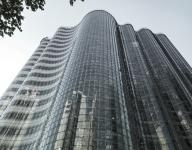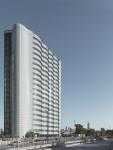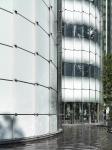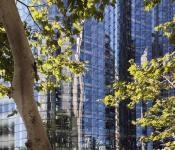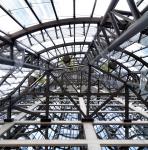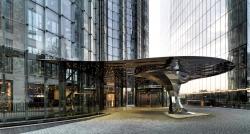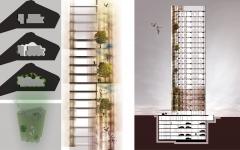The project for the office building to be situated on the Mecidiyekoy-Maslak axis, where Turkey’s foreign capital takes its most visible form, was conditioned by the tension between density of its environ and the tightness of the project site. It was the client’s wish that the building would be a prestigious building, just like all the other surrounding buildings which only meant to be prominent, having been developed with no certain rule, plan or order.
Apart from the other projects along the Buyukdere Avenue, which is the main business district of Istanbul, Maslak No.1 Office Tower was designed to enrich the quality of the typical office space by vertical gardens. In order to accomplish that, a rational office block which was planned over a 8.25 x 8.25 m grid, enveloped with a free formed glazing system was designed. The envelope, acting as a secondary facade in south and west direction is detached from the building up to 17 meters, let vertical gardens in 20 meters high. The space in-between two facades was considered as a buffer zone both for the acoustical and the climatic sense. The simple reinforced concrete office building with a basic, operable aluminum framing and glazing system helped in ease of construction and decrease in budget compared to similar investments, being free of direct wind load and sun rays. The envelope in steel structure, while creating the climatic control, provides the building with the prestige, identity and peculiarity through the crowd of alike structures that is a part of the client’s brief.
The curvilinear plan of the facade formed by the 150 x 200 cm rectangular modules was designed regarding the perception from the highway. These glass panels are arranged in the texture of fish-scale letting air flow through and they have a translucent film layer over it. The opacity of the film layer diverse, up to the orientation of the curvilinear facade; on southern facade a less transparent pattern was chosen; however in north, almost a transparent film was used which are designed according to environmental control issues.
The office buildings at this district are planned and are being managed as private gated communities, independently secured and controlled. No free access or passage is allowed even at the communal ground levels, that prevents any possible interaction with the street and neighboring alike complexes. As a matter of creating porosity on the urban level, a considerable part of the ground floor, together with the buffer zone and the outside terrace at Maslak No:1 Tower is kept except the secured, private areas of the building, that welcomes public freely with a hope that future developments or refurbishments at the region may carry on this attitude to empower the urban life throughout the district.
Concept Project presented at the beginning of 2009 was developed with all parties and local authorities until 2012. As opposed to many other projects in Turkey, the construction started then with all documents ready and completed in 2014 through a well-organized and controlled process.
Maslak No.1 is certified with LEED Gold and is considered among the high-qualified and highly-demanded office buildings of the district, in spite of notably simple choice of materials compared to the counterparts in the market, inhabiting national and international significant companies such as Deloitte as the main tenant.
Main volumetric composition of the project depends on a simple reinforced concrete office block and a porous envelope that controls the general climate of the building. While letting air flow through the glass panels arranged as fish-scale, the envelope filters direct effects of the climate. The in-between buffer zone, provided the design of the office framing dependent on most simplest parameters technically; low wind loads and least amount of uv control. The envelope also provided acoustic comfort, made natural ventilation possible at suitable seasons by operable windows which also decreases the sense of working in a plaza effect on employees. The existence and density of the dots on the film coating on these glass panels are designed parametrically according to the movement of the sun in order to decrease solar gain and to provide shade control while at the same time letting panoramas at eye level.
General office planning strategy takes into account the issues of flexibility and adaptability, designed in the scope of shell and core design. The carpark levels, lobby space and circulation core together with minimum amount of common restrooms were completed with simple finishes of optimum budgets. Large amount of exposed concrete and use of partial suspended ceiling elements, together with a simple local stone on the floor are the main materials used. The rest of the office floors were finished as a simple naked grid structure, to be equipped with raised floor and dry wall structures. Concrete surfaces were finished in a quality that once again encourages the tenant to keep it as exposed or with partial ceiling elements.
The building has maximum energy efficient design based on the latest technology in building materials, illumination and mechanical systems. The 3D Variable Refrigerant Volume (VRV) system and heat recoverable HVAC Units help it to reach high efficiency level, aiming to reach an energy saving level of 40% compared to buildings with similar features. The building is equipped with maximum cooling / heating and story based control with three tube VRV system and reinforced fresh air with recycling fresh air units. Regenerative elevators produce their own electricity, water efficient appliances and fixtures are installed, energy saving is provided by the use of LED and T5 lighting fixtures,
The location of the site had benefits of highway access for material supply during construction as well as its close proximity to public transport; bus and metro that are a few minutes walk away. Finally, the project tries to create an urban porosity on the ground level, as described in the project description text, as opposed to the rest of the district that would behave as seeds for a future consideration of urban access and communal use throughout the neighborhood.
2008
2014
EAA - Emre Arolat Architecture

